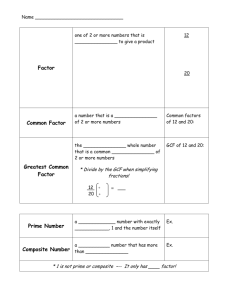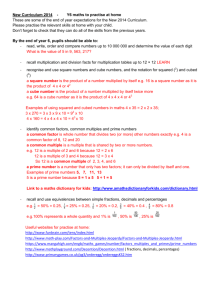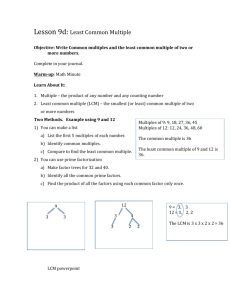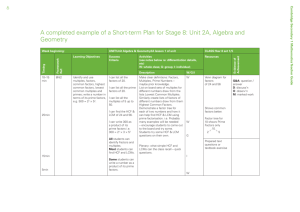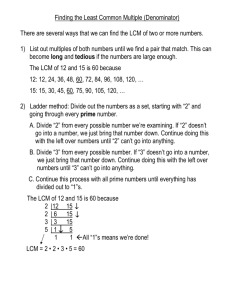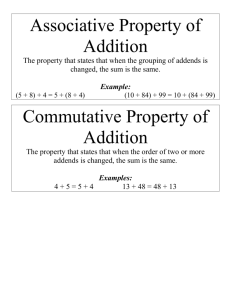FACTORS AND MULTIPLES - Fairfield Book Publisher
advertisement
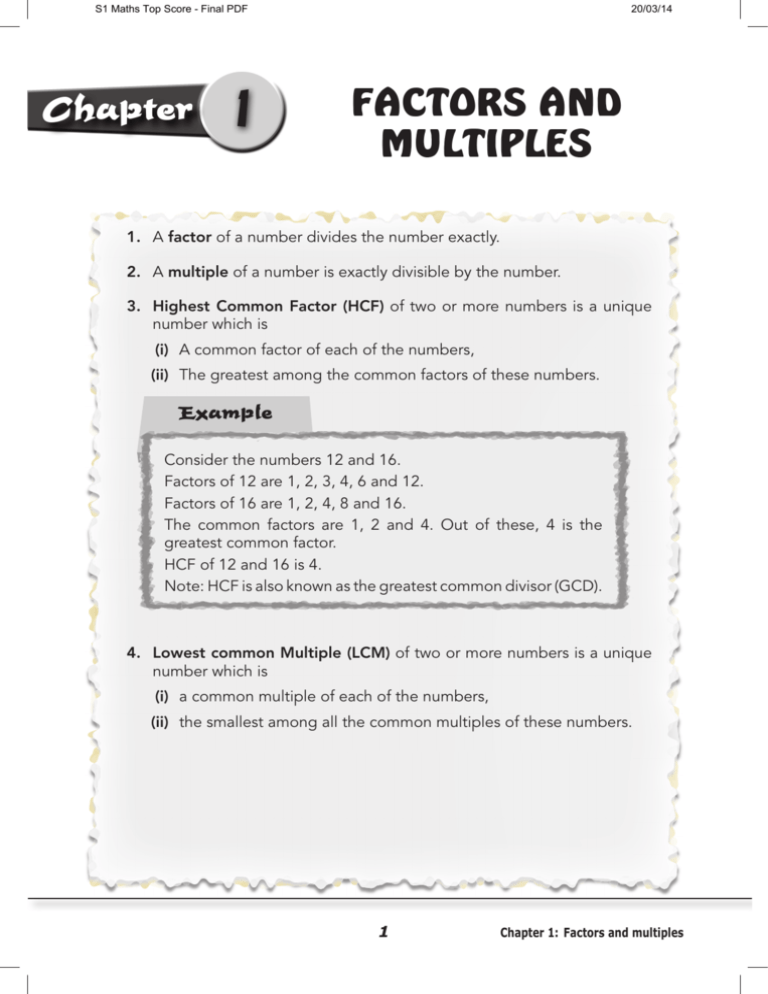
S1 Maths Top Score - Final PDF Chapter 1 20/03/14 FACTORS AND MULTIPLES 1.A factor of a number divides the number exactly. 2.A multiple of a number is exactly divisible by the number. 3. Highest Common Factor (HCF) of two or more numbers is a unique number which is (i) A common factor of each of the numbers, (ii) The greatest among the common factors of these numbers. Example Consider the numbers 12 and 16. Factors of 12 are 1, 2, 3, 4, 6 and 12. Factors of 16 are 1, 2, 4, 8 and 16. The common factors are 1, 2 and 4. Out of these, 4 is the greatest common factor. HCF of 12 and 16 is 4. Note: HCF is also known as the greatest common divisor (GCD). 4. Lowest common Multiple (LCM) of two or more numbers is a unique number which is (i) a common multiple of each of the numbers, (ii) the smallest among all the common multiples of these numbers. 1 Chapter 1: Factors and multiples S1 Maths Top Score - Final PDF 20/03/14 Example Consider the numbers 8 and 12. Multiples of 8 are 8, 16, 24, 32, 40, 48, ... Multiples of 12 are 12, 24, 48,... 24 is the smallest common multiple. LCM of 8 and 12 is 24. 5. The product of HCF and LCM of two numbers a and b is equal to the product of the numbers a × b. 6. The HCF of two numbers a and b is a factor of the LCM of a and b, likewise LCM of a and b is a multiple of HCF of a and b. 7. Prime number is a natural number which has only two different factors, 1 and itself. 8. Composite number is a natural number which has more than two different factors. 9. ‘Prime factorisation is the process of expressing a composite number as a product of its prime factors. 10. Number 1 is neither prime or composite. 2 is the only even prime number. 11. When a number, a, is multiplied by itself to get another number b, b is the square of a and a is the square root of b. Example Since 3 × 3 = 9. 9 is the square of 3 and 3 is the square root of 9. 12. When a number, a, is multiplied by itself thrice to get another number b, b is the cube of a and a is the cube root of b. Example Since 2 × 2 × 2 = 8. 8 is the cube of 2 and 2 is the cube root of 8. Secondary 1 Maths 2 S1 Maths Top Score - Final PDF 20/03/14 QUESTIONS 1. List all prime numbers between 80 and 100. 2. List all prime numbers between 101 and 130. 3. Find the sum of all prime numbers between 50 and 100. 4. Use the sieve of Eratosthenes to find all the prime numbers between 1 and 30. Which is the even prime number in the list? 5. Find the prime factorisation of the following. (a) 253 (b) 231 3 Chapter 1: Factors and multiples S1 Maths Top Score - Final PDF 20/03/14 (c) 1911 (d) 2145 (e) 3795 (f) 8008 (g) 15 625 (h) 51 051 (i) 41 503 6. Write the largest 4-digit number and express it as a product of its prime factors. Secondary 1 Maths 4 S1 Maths Top Score - Final PDF 20/03/14 7. Find the prime factors of 1729 and arrange them in ascending order. What is the relation between these prime factors? 8. Find the HCF of the following. (a) 144, 180, 192 (b) 106, 159, 265 (c) 625, 3125, 15 625 (d) 522, 1624, 1276 (e) 2241, 8217, 747 9. Two tankers contain 850 litres and 680 litres of petrol. Find the maximum capacity of a container which can measure the petrol of either tanker in exact number of times. 5 Chapter 1: Factors and multiples S1 Maths Top Score - Final PDF 20/03/14 10. I have 3 pieces of ropes of length 150 cm, 140 cm and 210 cm. I wish to cut these ropes into smaller pieces of equal length. What is the greatest possible length of each of the smaller pieces? 11. 120 pens, 255 pencils and 180 erasers are to be distributed to a group of children. Suppose each child in the group receives an equal number for each type of items, (a) find the maximum possible number of children in the group, (b) how many of each item will each child be receiving? 12. A rectangular area, 480 cm by 450 cm, is covered with the smallest number of square tiles. How many square tiles are needed? Secondary 1 Maths 6 S1 Maths Top Score - Final PDF 20/03/14 13. Find the LCM of the following. (a) 400,160 (b) 11,13 (c) 180,384,144 (d) 20,25,30,40 (e) 198,135,108,54,22 14. Find the HCF and LCM of the following. (a) 28 and 63. (b) 105, 189 and 420. 7 Chapter 1: Factors and multiples

